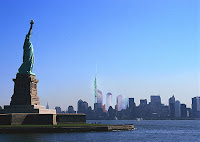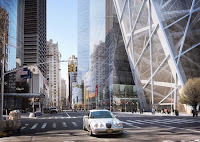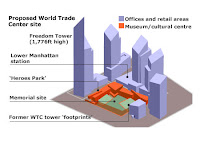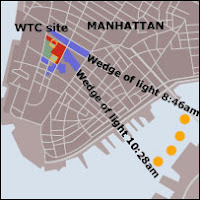

 While Americans and New Yorkers, in particular, debate the future of Ground Zero, the Lower Manhattan Development Corporation is moving ahead with plans to redevelop the former World Trade Center site. The plan calls for a 17-acre commercial/memorial complex which can service the economic needs of Manhattan while respectfully commemorating the 9/11 tragedy.
While Americans and New Yorkers, in particular, debate the future of Ground Zero, the Lower Manhattan Development Corporation is moving ahead with plans to redevelop the former World Trade Center site. The plan calls for a 17-acre commercial/memorial complex which can service the economic needs of Manhattan while respectfully commemorating the 9/11 tragedy.The plan for the site, designed by architect Daniel Libeskind, and selected in a pubic design competition last February, responds to these seemingly contradictory needs. Of his struggle to create a design that would satisfy the unique needs of the World Trade Center site, Libeskind says:
I meditated many days on this seemingly impossible dichotomy. To acknowledge the terrible deaths which occurred on this site, while looking to the future with hope, seemed like two moments which could not be joined. ... So, I went to look at the site, to stand within it, to see people walking around it, to feel its power and to listen to its voices.
Libeskind was so impressed with what remained of the World Trade Center foundations that his design preserves the tower footprints and provides for a journey down, some 70 feet, into Ground Zero onto the bedrock foundation beneath the monolithic slurry walls holding back the Hudson River. A museum – of the event, of memory, and of hope – will serve as the entrance into Ground Zero, always accessible, leading visitors down into a space of reflection, of meditation, and a space for the memorial. This memorial will be designed as part of an international competition.
To commemorate those who lost their lives on 9/11, the development features two large public places, the Park of Heroes and the Wedge of Light. Each year on September 11th between the hours of 8:46 a.m., when the first airplane hit, and 10:28 a.m., when the second tower collapsed, the sun will shine without shadow through the Wedge of Light onto the memorial site. A Heroes Walk will trace the firefighters' paths as they raced into the Trade Center and there will also be an elevated walkway – a promenade encircling the memorial site – reminiscent of the overlook walkway used by 4 million people to view Ground Zero after the attack.
Beyond the needs for a memorial, an exciting new Lower Manhattan Rail station will connect travelers to regional Path trains, subways, hotels, a performing arts center, office towers, underground malls, street level shops, restaurants, and cafes.
But perhaps the most visible and stunning architectural fixture of the new development will be the towering spire – the "Gardens of the World". Libeskind hopes the gardens, which will rise 1776 feet, in commemoration of our national independence – will serve as a constant affirmation of life while the metal and glass skyscraper "rises above its predecessors, reasserting the pre-eminence of freedom and beauty, and restoring the spiritual peak to the city – an icon of our vitality in the face of danger and our optimism in the aftermath of tragedy." fb





